#bonap
Explore tagged Tumblr posts
Text


Planted some trillium (recurvatum and cuneatum) last year and didn't think it made it but was thrilled to see them pop up today!
#remember to source your woodland plants from reputable nurseries ✨#realize now i shouldve gone for md natives but now that i know they'll grow ill keep my eye out#p sure theres a couple semi-local specialty nurseries with em but they're def a bit of an investment!#slowly but surely bonap is becoming my best friend
4 notes
·
View notes
Text




#not a lot of difference but i would like to know ............#v#inspired by people on reddit posting about how much helianthus tuberosus spreads and looking it up on bonap and seeing it's native to the#midwest and adventive on the east coast.#similar story with helianthus anuus but its native range spreads to the west coast
7 notes
·
View notes
Text
it would be even more amazing if you could search for your county and have it all linked to the bonap database but BOY would that be a long list. and a lot to implement.
absolutely blissful looking through native plant images
#i religiously search for if it has been documented in my county on bonap when buying plants but this is purely for pleasure.#and i already remember whats what from my bonanza last year.#v
5 notes
·
View notes
Text
I HIGHLY recommend checking out The Biota of North America Program.
You can also search but state and it gives you a list by scientific names and a full US map.
Native Plant Trust will also give you plants by your area!
2 notes
·
View notes
Text
How to Identify American Holly
Click here to learn more about the How to Identify article series.
Name: American Holly (Ilex opaca)
Range and typical habitat(s): Typically southeastern United States, from eastern Texas to the Atlantic coast, southern Missouri, and central Florida to scattered portions of New England. iNaturalist observations also place it in portions of Michigan, Illinois, Ohio, and Oklahoma, showing some expansion compared to the 2014 BONAP map, so its range may be expanding in response to climate change. In most of its range it is an understory tree growing in the shade of larger species. However, in Florida’s scrub habitat it grows as a shrub.
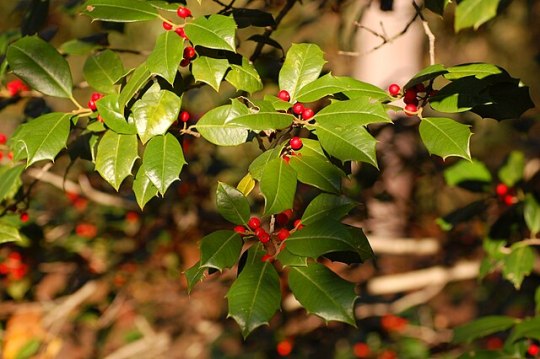
Photo by Derek Ramsay, GNU FDL 1.2
Distinguishing physical characteristics (size, colors, overall shapes, detail shapes): At first glance American holly looks quite similar to the European holly (Ilex aquifolium) so commonly used got holiday decorations (more about the differences between the two below.) It has medium to dark green oval-shaped leaves, sometimes with a yellowish tint, whose margins (edges) have concave curves between sharp points that are regularly spaced; large leaves may reach three inches long.
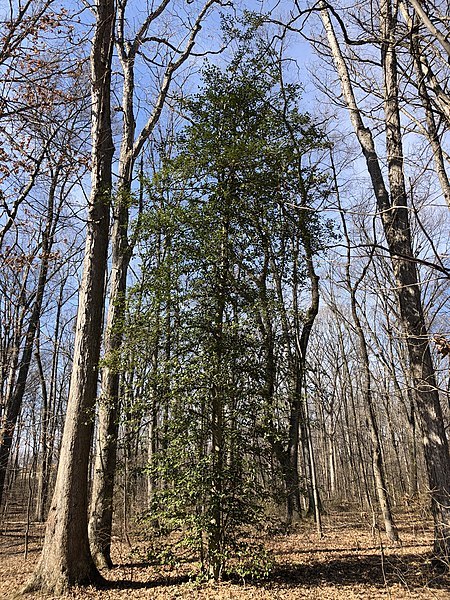
Photo by Famartin, CCA-SA-4.0-INTL
The American holly’s leaves have a leathery, stiff texture, and may appear waxy, and the underside is paler, often yellow in color. Each leaf has a central vein (midrib) that is depressed, appearing almost like a deep crease. Thinner veins branch off of both sides of the midrib. Some leaves may display smooth margins instead of the more typically spiky ones, especially when they are high enough to be out of the reach of browsing herbivores like deer.
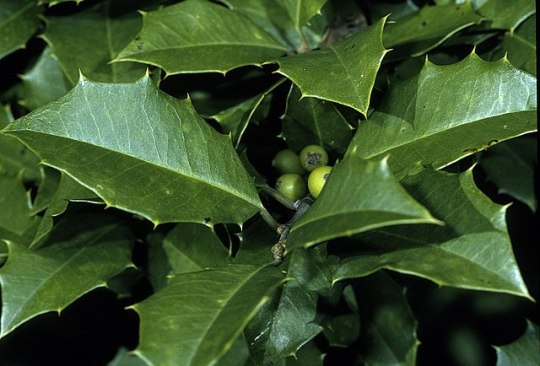
The foliage stays green throughout the year rather than being shed in fall; a given leaf may stay on the tree for up to three years before being displaced by a new replacement leaf. The leaves grow in an alternate pattern along a twig, with each leaf growing a little further along the twig than the last. The tree’s branches and trunk are covered in pale gray bark that is relatively smooth, but may have horizontal and vertical striations, along with various nodes and bumps, and might also play host to white patches of microlichen colonies. Other lichens, as well as mosses, also may add color to the American holly’s bark.
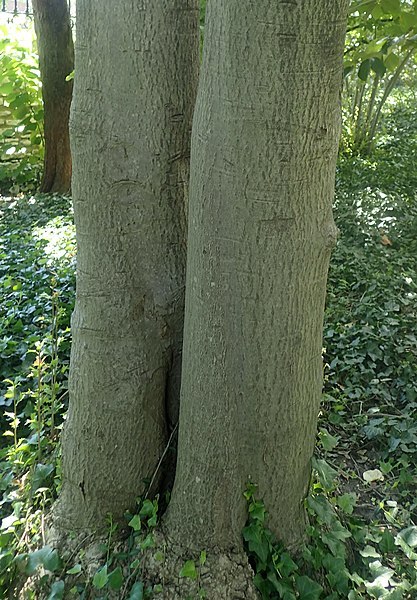
Photo by Krzysztof Ziarnek, CCA-SA-4.0-INTL
An exceptional specimen of American holly can reach almost 100 feet tall when mature, though it grows slowly. Such large trees are generally a century or more old, and the oldest on record was just a few years shy of 150.
The flowers of American holly are small (1/2″ or less across) with green centers and four (sometimes six) white petals that are broad with a rounded end, and whose tips curve back toward the plant. They grow in clusters of several flowers sprouting from one spot. American holly is dioecious, meaning that there are female and male plants; the males tend to reach sexual maturity a few years earlier than the females, but they all are generally reproducing by the age of ten.
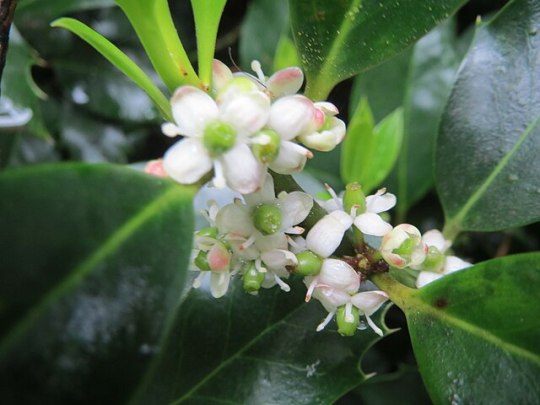
When fertilized by insects the female flowers then turn into the well-known red berries. Technically these are drupes rather than true berries, with four seeds apiece, and while they start out green they ripen to a bright red. The berries are popular with birds like cedar waxwings (Bombycilla cedrorum), but are toxic to humans and our pets.
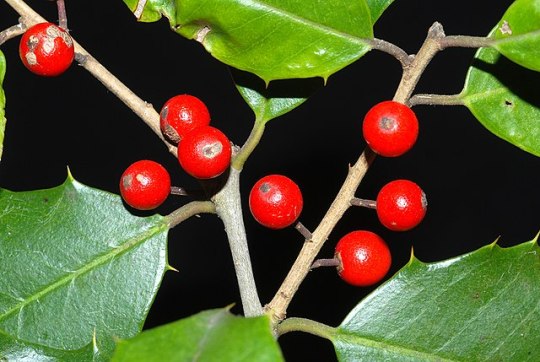
Photo by Douglas Goldman, CCA-SA-4.0
Other organisms it could be confused with and how to tell the difference: Due to their similarity, American holly and European holly may easily be confused at first glance, and both prefer the understory of a forest. However, the European species does not grow as large. The leaves of European holly are darker and have a glossier appearance; the edges may also be more warped where those of American holly lie comparatively flat. Moreover, European holly grows more commonly along the west coast of North America, and is more sparse throughout American holly’s native range, especially outside of cultivated spaces.

European holly (Ilex aquifolium)
Yaupon holly (Ilex vomitoria) is another species native to the southeastern North America, particularly the Gulf Coast states and the southern third of the Atlantic coast. It is a much smaller shrub that rarely exceeds thirty feet tall, and its leaves are round with serrated or scalloped edges rather than the pointed margins of American holly. The petals of the flowers may not curve as much as on American holly.

Yaupon holly (Ilex vomitoria)
Dahoon holly (Ilex cassine) also grows in the extreme southeastern United States, from Louisiana to the southern tip of North Carolina, and primarily along the coastline except in Florida where it can be found across much of the peninsula. Its leaves are longer and more slender than those of American holly, and the margins are almost entirely smooth except for a series of very small spikes.
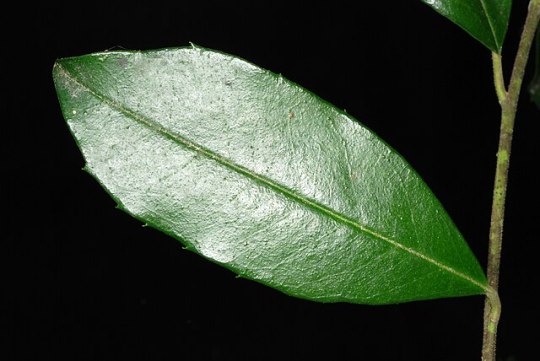
Dahoon holly (Ilex cassine). Photo by Douglas Goldman, CCA-SA-4.0
Possumhaw (Ilex decidua) has long, slender leaves with a gently pointed tip and serrated edges. This deciduous plant drops its leaves in fall, unlike the evergreen American holly.

Possumhaw (Ilex decidua)
There are other plants that have similar leaves to American holly but that grow out of its range, such as the various species of Oregon grape (Mahonia spp.) in the Pacific Northwest, and holm oak (Quercus ilex), for which the genus Ilex was originally named.
Further reading:
USDA: American Holly
North Carolina Extension Gardener Plant Toolbox: Ilex opaca
Missouri Botanical Garden Plant Finder: Ilex opaca
Native Plant Trust: Ilex opaca – American holly
University of Connecticut Plant Database: Ilex opaca
Did you enjoy this post? Consider taking one of my online foraging and natural history classes or hiring me for a guided nature tour, checking out my other articles, or picking up a paperback or ebook I’ve written! You can even buy me a coffee here!
#holly#American holly#North America#native plants#Ilex#shrubs#plants#plant identification#nature identification#botany#trees#ecology#conservation#biodiversity#long post#nature#Yule#Christmas#holidays#scicomm
12 notes
·
View notes
Text
The Native Plant trust is Fantastic. But I would like to add BONAP: The Biota of North America Program. You can use the NAPA- North American Plant Atlas and see what it is your state by Genus. And it will show you if it is native or rare or invasive, it's brilliant.
Planet's Fucked: What Can You Do To Help? (Long Post)
Since nobody is talking about the existential threat to the climate and the environment a second Trump term/Republican government control will cause, which to me supersedes literally every other issue, I wanted to just say my two cents, and some things you can do to help. I am a conservation biologist, whose field was hit substantially by the first Trump presidency. I study wild bees, birds, and plants.
In case anyone forgot what he did last time, he gagged scientists' ability to talk about climate change, he tried zeroing budgets for agencies like the NOAA, he attempted to gut protections in the Endangered Species Act (mainly by redefining 'take' in a way that would allow corporations to destroy habitat of imperiled species with no ramifications), he tried to do the same for the Migratory Bird Treaty Act (the law that offers official protection for native non-game birds), he sought to expand oil and coal extraction from federal protected lands, he shrunk the size of multiple national preserves, HE PULLED US OUT OF THE PARIS CLIMATE AGREEMENT, and more.
We are at a crucial tipping point in being able to slow the pace of climate change, where we decide what emissions scenario we will operate at, with existential consequences for both the environment and people. We are also in the middle of the Sixth Mass Extinction, with the rate of species extinctions far surpassing background rates due completely to human actions. What we do now will determine the fate of the environment for hundreds or thousands of years - from our ability to grow key food crops (goodbye corn belt! I hated you anyway but), to the pressure on coastal communities that will face the brunt of sea level rise and intensifying extreme weather events, to desertification, ocean acidification, wildfires, melting permafrost (yay, outbreaks of deadly frozen viruses!), and a breaking down of ecosystems and ecosystem services due to continued habitat loss and species declines, especially insect declines. The fact that the environment is clearly a low priority issue despite the very real existential threat to so many people, is beyond my ability to understand. I do partly blame the public education system for offering no mandatory environmental science curriculum or any at all in most places. What it means is that it will take the support of everyone who does care to make any amount of difference in this steeply uphill battle.
There are not enough environmental scientists to solve these issues, not if public support is not on our side and the majority of the general public is either uninformed or actively hostile towards climate science (or any conservation science).
So what can you, my fellow Americans, do to help mitigate and minimize the inevitable damage that lay ahead?
I'm not going to tell you to recycle more or take shorter showers. I'll be honest, that stuff is a drop in the bucket. What does matter on the individual level is restoring and protecting habitat, reducing threats to at-risk species, reducing pesticide use, improving agricultural practices, and pushing for policy changes. Restoring CONNECTIVITY to our landscape - corridors of contiguous habitat - will make all the difference for wildlife to be able to survive a changing climate and continued human population expansion.
**Caveat that I work in the northeast with pollinators and birds so I cannot provide specific organizations for some topics, including climate change focused NGOs. Scientists on tumblr who specialize in other fields, please add your own recommended resources. **
We need two things: FUNDING and MANPOWER.
You may surprised to find that an insane amount of conservation work is carried out by volunteers. We don't ever have the funds to pay most of the people who want to help. If you really really care, consider going into a conservation-related field as a career. It's rewarding, passionate work.
At the national level, please support:
The Nature Conservancy
Xerces Society for Invertebrate Conservation
Cornell Lab of Ornithology (including eBird)
National Audubon Society
Federal Duck Stamps (you don't need to be a hunter to buy one!)
These first four work to acquire and restore critical habitat, change environmental policy, and educate the public. There is almost certainly a Nature Conservancy-owned property within driving distance of you. Xerces plays a very large role in pollinator conservation, including sustainable agriculture, native bee monitoring programs, and the Bee City/Bee Campus USA programs. The Lab of O is one of the world's leaders in bird research and conservation. Audubon focuses on bird conservation. You can get annual memberships to these organizations and receive cool swag and/or a subscription to their publications which are well worth it. You can also volunteer your time; we need thousands of volunteers to do everything from conducting wildlife surveys, invasive species removal, providing outreach programming, managing habitat/clearing trails, planting trees, you name it. Federal Duck Stamps are the major revenue for wetland conservation; hunters need to buy them to hunt waterfowl but anyone can get them to collect!
THERE ARE DEFINITELY MORE, but these are a start.
Additionally, any federal or local organizations that seek to provide support and relief to those affected by hurricanes, sea level rise, any form of coastal climate change...
At the regional level:
These are a list of topics that affect major regions of the United States. Since I do not work in most of these areas I don't feel confident recommending specific organizations, but please seek resources relating to these as they are likely major conservation issues near you.
PRAIRIE CONSERVATION & PRAIRIE POTHOLE WETLANDS
DRYING OF THE COLORADO RIVER (good overview video linked)
PROTECTION OF ESTUARIES AND SALTMARSH, ESPECIALLY IN THE DELAWARE BAY AND LONG ISLAND (and mangroves further south, everglades etc; this includes restoring LIVING SHORELINES instead of concrete storm walls; also check out the likely-soon extinction of saltmarsh sparrows)
UNDAMMING MAJOR RIVERS (not just the Colorado; restoring salmon runs, restoring historic floodplains)
NATIVE POLLINATOR DECLINES (NOT honeybees. for fuck's sake. honeybees are non-native domesticated animals. don't you DARE get honeybee hives to 'save the bees')
WILDLIFE ALONG THE SOUTHERN BORDER (support the Mission Butterfly Center!)
INVASIVE PLANT AND ANIMAL SPECIES (this is everywhere but the specifics will differ regionally, dear lord please help Hawaii)
LOSS OF WETLANDS NATIONWIDE (some states have lost over 90% of their wetlands, I'm looking at you California, Ohio, Illinois)
INDUSTRIAL AGRICULTURE, esp in the CORN BELT and CALIFORNIA - this is an issue much bigger than each of us, but we can work incrementally to promote sustainable practices and create habitat in farmland-dominated areas. Support small, local farms, especially those that use soil regenerative practices, no-till agriculture, no pesticides/Integrated Pest Management/no neonicotinoids/at least non-persistent pesticides. We need more farmers enrolling in NRCS programs to put farmland in temporary or permanent wetland easements, or to rent the land for a 30-year solar farm cycle. We've lost over 99% of our prairies to corn and soybeans. Let's not make it 100%.
INDIGENOUS LAND-BACK EFFORTS/INDIGENOUS LAND MANAGEMENT/TEK (adding this because there have been increasing efforts not just for reparations but to also allow indigenous communities to steward and manage lands either fully independently or alongside western science, and it would have great benefits for both people and the land; I know others on here could speak much more on this. Please platform indigenous voices)
HARMFUL ALGAL BLOOMS (get your neighbors to stop dumping fertilizers on their lawn next to lakes, reduce agricultural runoff)
OCEAN PLASTIC (it's not straws, it's mostly commercial fishing line/trawling equipment and microplastics)
A lot of these are interconnected. And of course not a complete list.
At the state and local level:
You probably have the most power to make change at the local level!
Support or volunteer at your local nature centers, local/state land conservancy non-profits (find out who owns&manages the preserves you like to hike at!), state fish & game dept/non-game program, local Audubon chapters (they do a LOT). Participate in a Christmas Bird Count!
Join local garden clubs, which install and maintain town plantings - encourage them to use NATIVE plants. Join a community garden!
Get your college campus or city/town certified in the Bee Campus USA/Bee City USA programs from the Xerces Society
Check out your state's official plant nursery, forest society, natural heritage program, anything that you could become a member of, get plants from, or volunteer at.
Volunteer to be part of your town's conservation commission, which makes decisions about land management and funding
Attend classes or volunteer with your land grant university's cooperative extension (including master gardener programs)
Literally any volunteer effort aimed at improving the local environment, whether that's picking up litter, pulling invasive plants, installing a local garden, planting trees in a city park, ANYTHING. make a positive change in your own sphere. learn the local issues affecting your nearby ecosystems. I guarantee some lake or river nearby is polluted
MAKE HABITAT IN YOUR COMMUNITY. Biggest thing you can do. Use plants native to your area in your yard or garden. Ditch your lawn. Don't use pesticides (including mosquito spraying, tick spraying, Roundup, etc). Don't use fertilizers that will run off into drinking water. Leave the leaves in your yard. Get your school/college to plant native gardens. Plant native trees (most trees planted in yards are not native). Remove invasive plants in your yard.
On this last point, HERE ARE EASY ONLINE RESOURCES TO FIND NATIVE PLANTS and LEARN ABOUT NATIVE GARDENING:
Xerces Society Pollinator Conservation Resource Center
Pollinator Pathway
Audubon Native Plant Finder
Homegrown National Park (and Doug Tallamy's other books)
National Wildlife Federation Native Plant Finder (clunky but somewhat helpful)
Heather Holm (for prairie/midwest/northeast)
MonarchGard w/ Benjamin Vogt (for prairie/midwest)
Native Plant Trust (northeast & mid-atlantic)
Grow Native Massachusetts (northeast)
Habitat Gardening in Central New York (northeast)
There are many more - I'm not familiar with resources for western states. Print books are your biggest friend. Happy to provide a list of those.
Lastly, you can help scientists monitor species using citizen science. Contribute to iNaturalist, eBird, Bumblebee Watch, or any number of more geographically or taxonomically targeted programs (for instance, our state has a butterfly census carried out by citizen volunteers).
In short? Get curious, get educated, get involved. Notice your local nature, find out how it's threatened, and find out who's working to protect it that you can help with. The health of the planet, including our resilience to climate change, is determined by small local efforts to maintain and restore habitat. That is how we survive this. When government funding won't come, when we're beat back at every turn trying to get policy changed, it comes down to each individual person creating a safe refuge for nature.
Thanks for reading this far. Please feel free to add your own credible resources and organizations.
18K notes
·
View notes
Photo


this is mlm-wlw solidarity
36 notes
·
View notes
Text
Christina in the new bonap video is calling a girl called emma in her house...is she....you know..... bonap diehard fans please tell me i need to know
8 notes
·
View notes
Text
okay now go out and do this IRL with actual endangered species
BTW it is actually not that hard to do with plants on a local scale, especially with species that are still common in parts of their range, but have become locally endangered. I have managed to reintroduce two locally-extirpated species in my county, and they are now thriving, and if you go even more micro than that, you can reintroduce species to small, fragmented habitats like small forested parks in urban areas.
if you reintroduce native plant species, typically the animals that depend on them will just show up, usually because insects show up to eat the plants and then as enough insects you get more animals like birds and small mammals that eat both insects and seeds, and then it turn these support other animals.
you can start getting into this by using tools like iNaturalist, and BONAP to look up how to ID things and what is native to your area and such. I also run bplant.org which also has resources on what is native where and links to all sorts of other sites
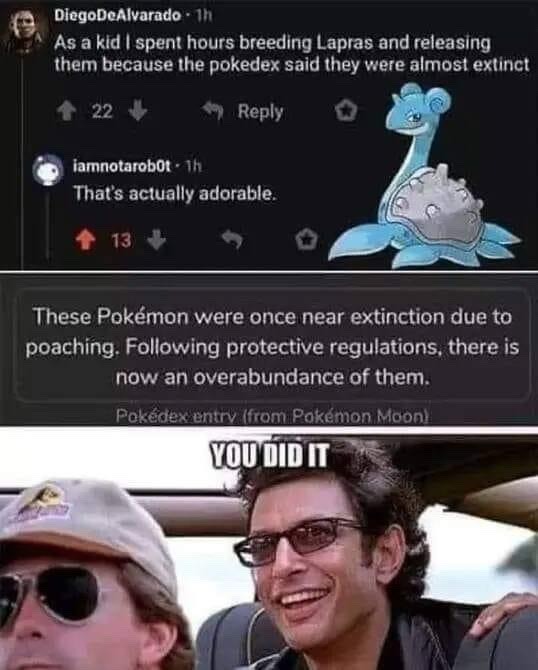
67K notes
·
View notes
Text

benhardy1: When there's a great view behind you but a far better one in front of you @joemazzello
I guess cardboard ben is jealous now
#bohemian rapsody movie#ben hardy#joe mazzello#rami malek#gwylim lee#borhap#bonap#bohemian rhapsody#freddie mercury#roger taylor#brian may#john deaky#john deacon#instagram#benhardy1#cardboardben
81 notes
·
View notes
Text

I just squealed on a bus full of kids omg this is too pure😍😍
#my heart#omg#theyre so cute#i cant handle it#loves of my life#i could scream#😍😍😍#queen#bohemian rhapsody#BoNap#borhap#i promise im writing this fic#its taking longer than i wanted to post it#but i think im almost done#i promise#brian may#gwilyn lee#freddie mercury#rami malek#roger taylor#ben hardy#john deacon#joe mazzello
17 notes
·
View notes
Photo
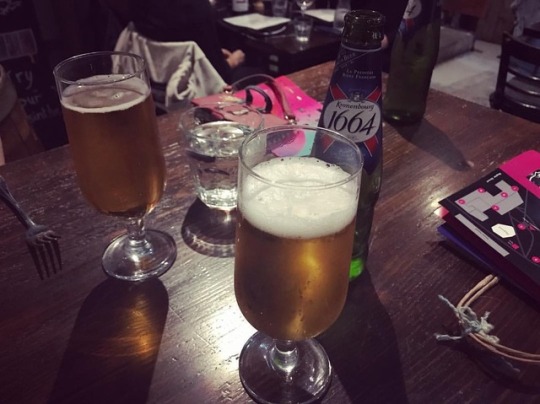
👯♀️ ᴍᴇʀᴄɪ ᴇᴛ ʙᴏɴ ᴀᴘᴘᴇᴛɪᴛᴇ 🥂 - thαnkѕ fσr αll thє lσvєlч вírthdαч wíѕhєѕ αnd gíftѕ 😘🙏 - #saturdaynight #bonap #fitzroy #brunswickstreet #bonappetitbistro #authentic #frenchrestaurant #melbourne #australia #weekend #1664blanc #jambon #etc #goodtimegoodcompany #melblife (at Bon Ap) https://www.instagram.com/p/BoDoPVkFG47/?utm_source=ig_tumblr_share&igshid=1gzk1y6r9cyh0
#saturdaynight#bonap#fitzroy#brunswickstreet#bonappetitbistro#authentic#frenchrestaurant#melbourne#australia#weekend#1664blanc#jambon#etc#goodtimegoodcompany#melblife
1 note
·
View note
Text
Jokes aside, these tend to have weed in their names because of colonialism. Every plant listed here has a native range, or is a common name for multiple species each with their own native range.
Smartweed for instance, genus Persicaria, has 15 species that grow in my area and only 5 are non-native. You can't just assume something is a weed because of it's name. I am actively ripping out Persicaria Maculosa amd planting Persicaria Pensylvanica.
Please I'm begging you
entry level weed for beginners
34K notes
·
View notes
Photo

先月末に、神戸三宮のフランス🇫🇷の食材セレクトショップ「Bon'ap❗️(ボンナップ❗️」でモロッコ🇲🇦産カサブランカビールとフランス🇫🇷産マスタード買った時にサービスして頂いた抹茶がオシャレにデコレーションされたチョコレートを、自作デザインマグカップに淹れた牛乳で頂いた画像を今ごろアップした。 #bonap #ボンナップ #神戸 #三宮 #御幸通 #フランス食材 #フランスアンテナショップ #アンテナショップ #チョコレート #hiraei #hiraeiart #eiichihiraseartwork #SUZURI #suzuriで販売中 #suzurijp #マグカップ #nowar https://www.instagram.com/p/CQ3ryt_Jm9k/?utm_medium=tumblr
#bonap#ボンナップ#神戸#三宮#御幸通#フランス食材#フランスアンテナショップ#アンテナショップ#チョコレート#hiraei#hiraeiart#eiichihiraseartwork#suzuri#suzuriで販売中#suzurijp#マグカップ#nowar
0 notes
Text
COOKING TALES
Kan ik jullie een geheim vertellen? Er zijn twee Jeroenen in mijn leven 😉 De eerste en belangrijkste is mijn zoon, van wie ik geen foto publiceer, want dat vind hij niet tof 🙂 Het volstaat te zeggen dat hij de liefste, knapste en gevoeligste man is op deze aardbol. (Op de voet gevolgd door guitar man 😉 ) De tweede is Jeroen Meus. De televisiekok die op zijn ontwapenende jongensachtige manier…

View On WordPress
0 notes